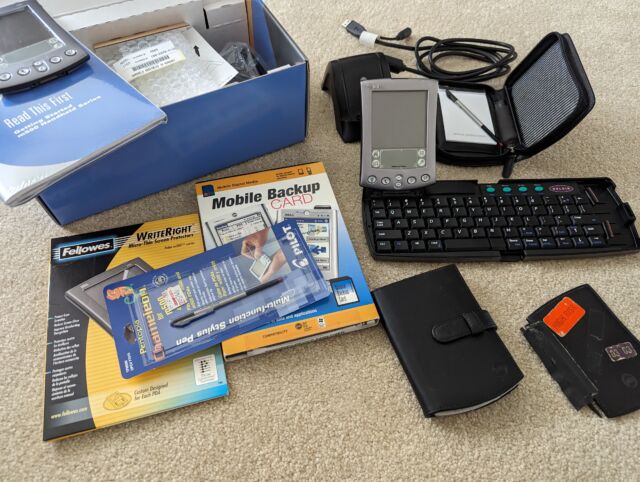Also notable about Palm’s SD/MMC implementation was multiple card support, though this wasn’t leveraged much, and FAT compatibility (via the new Virtual File System API). Using FAT as the file system meant files could be read and written as “regular files” on SD/MMC cards instead of having to wrap them up as databases, and cards could be interchanged with desktop computers.
Palm OS 4.0 also continued the improved memory management first introduced in 3.5, sizing the dynamic heap based on the amount of memory in the device rather than enforcing a fixed amount on all devices. Models with at least 2MB of RAM now supported 128K of dynamic memory, and units with at least 4MB, including the m500 series, supported 256K. After the system took its own working allocations, applications had up to 56K and 184K available, respectively, on most units. It still wasn’t much, but it was certainly an improvement.

The m505 wasn’t a perfect device, mind you. Its backlight wasn’t great, it used a lot of battery power, and everyone wanted more storage—all problems addressed by the successor m515. Meanwhile, by this time, the PDA market had exploded and had its own peripherals and accessories and shops specializing in them. Run down to your local CompUSA or Circuit City, and you could pick up a foldable keyboard, utility styluses (ironically, the best stylus I ever used was made by the Pilot Pen Corporation itself, with an actual ballpoint pen inside), cases, screen protectors, backup and game software, and more. For something originally intended as an accessory, we sure were using them as devices in their own right by then.
Send in (some of) the clones
Post-spinoff, 3Com CEO Eric Benhamou’s liberal Palm licensing policy continued and even broadened. Handspring notwithstanding, some of the most inventive Palm devices weren’t ever made by Palm.
No discussion of Palm clones can be considered complete without remarking upon the Sony CLIÉ series, which Sony first introduced with the PEG-S300 in Japan in September 2000. It used a 16MHz DragonBall with 8MB of RAM running 3.5 on a 16-grey display, adding a unique jog-dial scroll wheel and support for Sony’s Memory Stick, both of which became trademarks of the line. The Memory Stick slot was ostensibly to serve as a general-purpose expansion slot, but it could also provide up to an additional 8MB as storage (though databases and apps could not yet be run from it). It, too, had a USB cradle and sold for $399.
Sony was probably the longest-lived clone manufacturer and almost certainly the biggest seller, producing devices with on-board cameras and audio players in daring form factors, some of them even sporting their own keyboards. TRG also deserves a mention not only for developing the first Compact Flash-capable Palm (the July 2000 TRGpro) that could even accommodate IBM MicroDrives but also the HandEra 330 in April 2001, the first device with a 240x320 1.5x density screen and virtual on-screen Graffiti input, plus multiple card storage options and a jog dial. (Unfortunately, it also had compatibility issues and slow tap response, and the device was criticized by reviewers as clumsy.)
However, two clone devices particularly stand out to me and were the only classic Palm devices ever made of their kinds. One was a laptop, and one was a watch.

Although the 2000 Palm IPO under then-CEO Carl Yankowski was very successful, Yankowski was a controversial figure within the company, and Benhamou suffered his own share of criticism at 3Com for entering handheld computing in the first place. Though Benhamou was removed as CEO of 3Com in January 2001, he didn’t have long to wait for his new job; Yankowski was forced out from Palm in November after Benhamou convinced Palm’s board of directors to double down on licensing the operating system and split the company.
Benhamou took over as Palm CEO, and in January 2002, Palm announced the new PalmSource subsidiary that would own and license the Palm OS source code. PalmSource spun off completely in October 2003 and Palm renamed itself palmOne, incorporating the now ailing Handspring, which it bought in June 2003 (bringing Hawkins, Dubinsky, and Colligan back to their original company). Benhamou remained as chairman of both halves of Palm.
Besides servicing existing licensees, new ones were courted by PalmSource, including edutech company AlphaSmart. AlphaSmart was already known as a manufacturer of battery-powered portable word processing devices where text could be typed into units and then “sent” (over a keyboard port) to a computer, initially Macs via Apple Desktop Bus, to prep for style and publication. Originally running a custom minimal OS using the Motorola 68HC11, they were famous for their light weight, durability, and long battery life, and they became popular in schools and with journalists. However, AlphaSmart was already branching out to more general-purpose machines; the 3000 could run its own custom applets. From there, it was a simple step to graft in a DragonBall instead, and AlphaSmart became a new licensee of the Palm OS for the June 2002 Dana.
reader comments
200